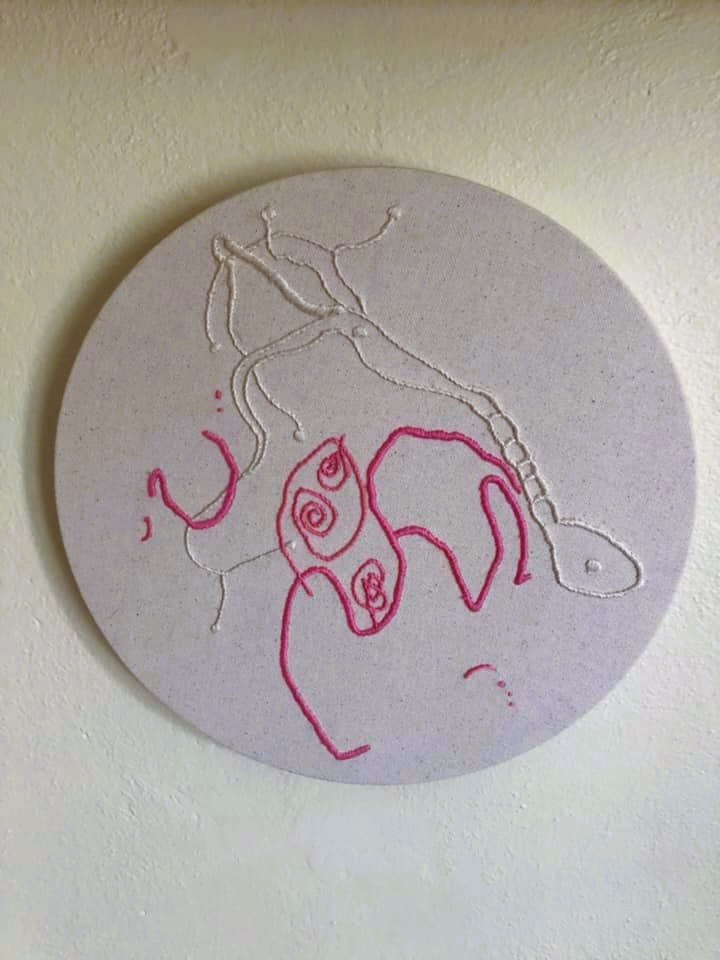Jennifer McRorie is known in the city for her work as curator and executive director of the Moose Jaw Museum & Art Gallery, but the exhibition currently touring Saskatchewan is a good reminder that she is an accomplished artist in her own right.
Family Ties, sponsored by the Organization of Saskatchewan Arts Councils (OSAC), is in the Art Gallery of Outlook until Oct. 23. It will be touring the province for the next two years, with its final show to take place at the Moose Jaw Cultural Centre from Nov. 1 – 23, 2023.
The artists in the exhibition are Belinda Harrow, McRorie, Elizabeth Munro, and Wendy Winter. The theme is the exploring of familial bonds through fibre-based work.
“I am not a fibre artist, I don’t really know how to embroider, so I’m just learning as I go, I guess,” McRorie said. “I tell myself I’m drawing in thread, so that gives me the liberty I need to not have a pristine embroidered surface.”
McRorie’s work within Family Ties is titled “She Will Make Her Own Mark.” It is an embroidery series based on her daughter’s drawings.
McRorie has two degrees in painting. She has an undergraduate degree from the Fine Arts program at the University of Regina. Her second degree, an M.A. in painting, was completed at the University of Canterbury in New Zealand.
Harrow was the artist who recommend McRorie go to New Zealand. Harrow was born in New Zealand before moving to Saskatchewan around the age of four. When McRorie curated a show that Harrow was involved in, she mentioned she was looking for a master’s program in fine arts that focused on the work rather than the theory — Harrow was happy to recommend the program she herself had done.
“Curating is pretty demanding, so I don’t get into the studio a lot,” said McRorie, whose husband is also an artist. “But I have tried to keep making work, and the embroidery project was something I started while on maternity leave.”
McRorie’s daughter has Williams syndrome (WS) — a genetic disorder that manifests in many ways but is particularly noted for challenges involving visuo-spatial tasks such as drawing and painting.
“I remember saying to my husband, ‘Isn’t it ironic that the two of us, being artists, might have a child who can’t draw?’ So, the way it was explained to me is that if you ask a person with WS to draw a happy face, they could draw the eyes and nose and mouth, but the components will be separate. Spatially putting it together is challenging.”
However, she soon realized that spatial difficulties cannot stop a person from creating art.
“My daughter, when she started making even these little scribbles, I loved the freeness of her lines and how uninhibited she is when she draws. She isn’t trying to make it look like something, she’s just trying to express herself.
“My idea was to embroider her drawings to show that this is art, and she will make her own mark and she will express herself.”
That means the exhibition is a collaboration between mother and daughter — something McRorie’s daughter is pretty thrilled about.
The titles in the series are original, with brilliant names such as “Goat Under a Tree,” “My Kitty Wearing Mouse Pajamas,” and “Shark in the Ocean.”
McRorie continues to be inspired by her daughter’s developing creativity. She is currently working on another collaboration that will bring her painting experience to the fore, using negative space and abstract representations of DNA.
Check the OSAC website at osac.ca/visual-media-arts/exhibition/157/Family%2BTies to learn more about the exhibition and to download the Family Ties education guide, which includes artistic activities you can try yourself.




